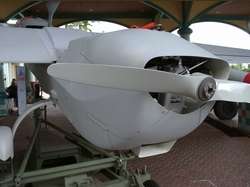Promises Higher Performance, Lower Costs for Hunter Unmanned
Aerial Vehicle
The Army's RQ-5A Hunter UAV will be able to climb faster,
operate at higher altitudes, and spend less time being serviced
thanks to the integration of a heavy-fuel engine on the air vehicle
by Northrop Grumman Corporation, the Hunter prime contractor.

The new engine, which recently completed a four-month
engineering test and flight demonstration program, also helps
advance the Army's goal of using JP-8 as the single fuel for all of
its land-and air-based weapon systems.
Heavy fuels are diesel- or kerosene-like fuels used to run
diesel and jet engines in Army platforms such as helicopters, tanks
and HMMWVs. They are less expensive and more available than the
aviation MOGAS fuels currently used to power the service's fleet of
tactical UAVs such as Hunter and Predator.
With the completion of its 28th engineering test flight on April
28, the Hunter heavy-fuel engine is on track to be retrofitted into
the flight vehicles beginning this September. Hunter will be the
first operational UAV to be powered by a common rail, direct
injection, compression ignition, reciprocating piston engine that
uses heavy fuel.
"The Hunter heavy-fuel engine is the latest success story for a
program that has experienced continuous improvement throughout its
life," said Donna Hightower, lead Medium Altitude Endurance
engineer at the Army's Unmanned Aerial Vehicle Systems Project
Office. "The test program revealed significant improvements in the
UAV's climb rate, service ceiling and fuel consumption rates."

Northrop Grumman conducted the Hunter flight tests at its
facility in Sierra Vista (AZ). The test program began on Dec. 17,
2003, the 100th anniversary of mechanized flight.
"The nation's armed forces have wanted heavy fuel engines for a
long time because heavy fuel is safer to store and transport than
gasoline and aviation fuel," said John Holschlag, Northrop
Grumman's Hunter chief engineer. "Our test program clearly
demonstrated the capability of this engine to extend the service
life of the Hunter UAVs and simplify the Army's logistics
process."
 Currently operating in Northern
Iraq, Hunter UAVs have flown approximately 2,160 missions totaling
approximately 11,223 fight hours as of May 2 in support of
Operations Enduring Freedom and Iraqi Freedom, and peacekeeping
efforts in the Balkans. No missions have been cancelled for reasons
other than extreme weather limitations. In June 2004, the Hunter
UAV reached the 5,000 combat flight-hour milestone over the skies
of Baghdad.
Currently operating in Northern
Iraq, Hunter UAVs have flown approximately 2,160 missions totaling
approximately 11,223 fight hours as of May 2 in support of
Operations Enduring Freedom and Iraqi Freedom, and peacekeeping
efforts in the Balkans. No missions have been cancelled for reasons
other than extreme weather limitations. In June 2004, the Hunter
UAV reached the 5,000 combat flight-hour milestone over the skies
of Baghdad.
The Hunter tactical UAV allows commanders to look deep into
enemy territory by collecting and relaying real-time day/night
video surveillance back to ground control and mission monitoring
stations for intelligence-gathering and target-acquisition
information. It is the first UAV to be put into operational use by
the Army. It also serves as the service's interim extended-range
multipurpose fixed-wing air vehicle. Originally designed to carry
only sensor payloads, Hunter has been modified to carry munitions
as well.
 Classic Aero-TV: The Switchblade Flying Car FLIES!
Classic Aero-TV: The Switchblade Flying Car FLIES! ANN FAQ: Q&A 101
ANN FAQ: Q&A 101 ANN's Daily Aero-Term (04.12.24): Discrete Code
ANN's Daily Aero-Term (04.12.24): Discrete Code ANN's Daily Aero-Term (04.13.24): Beyond Visual Line Of Sight (BVLOS)
ANN's Daily Aero-Term (04.13.24): Beyond Visual Line Of Sight (BVLOS) ANN's Daily Aero-Linx (04.13.24)
ANN's Daily Aero-Linx (04.13.24)




